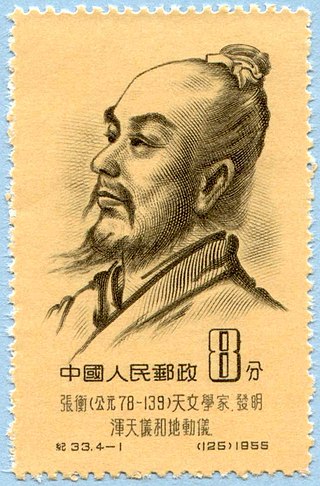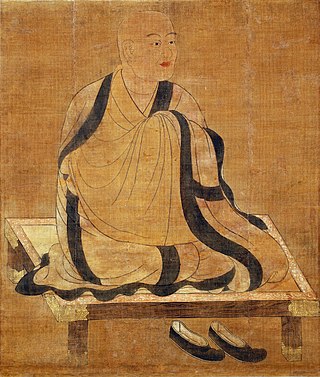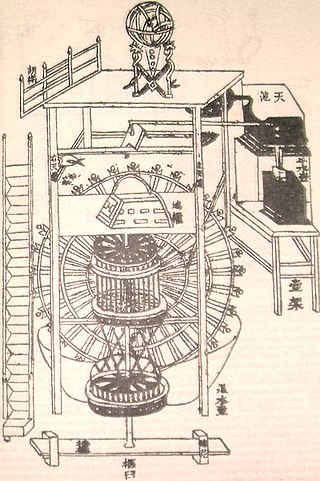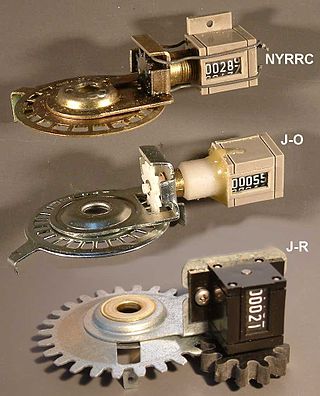In digital logic and computing, a counter is a device which stores the number of times a particular event or process has occurred, often in relationship to a clock. The most common type is a sequential digital logic circuit with an input line called the clock and multiple output lines. The values on the output lines represent a number in the binary or BCD number system. Each pulse applied to the clock input increments or decrements the number in the counter.

Zhang Heng, formerly romanized as Chang Heng, was a Chinese polymathic scientist and statesman who lived during the Han dynasty. Educated in the capital cities of Luoyang and Chang'an, he achieved success as an astronomer, mathematician, seismologist, hydraulic engineer, inventor, geographer, cartographer, ethnographer, artist, poet, philosopher, politician, and literary scholar.

An odometer or odograph is an instrument used for measuring the distance traveled by a vehicle, such as a bicycle or car. The device may be electronic, mechanical, or a combination of the two (electromechanical). The noun derives from ancient Greek ὁδόμετρον, hodómetron, from ὁδός, hodós and μέτρον, métron ("measure"). Early forms of the odometer existed in the ancient Greco-Roman world as well as in ancient China. In countries using Imperial units or US customary units it is sometimes called a mileometer or milometer, the former name especially being prevalent in the United Kingdom and among members of the Commonwealth.

A watermill or water mill is a mill that uses hydropower. It is a structure that uses a water wheel or water turbine to drive a mechanical process such as milling (grinding), rolling, or hammering. Such processes are needed in the production of many material goods, including flour, lumber, paper, textiles, and many metal products. These watermills may comprise gristmills, sawmills, paper mills, textile mills, hammermills, trip hammering mills, rolling mills, wire drawing mills.

A water wheel is a machine for converting the energy of flowing or falling water into useful forms of power, often in a watermill. A water wheel consists of a wheel, with a number of blades or buckets arranged on the outside rim forming the driving car. Water wheels were still in commercial use well into the 20th century but they are no longer in common use. Uses included milling flour in gristmills, grinding wood into pulp for papermaking, hammering wrought iron, machining, ore crushing and pounding fibre for use in the manufacture of cloth.

A wheelbarrow is a small hand-propelled vehicle, usually with just one wheel, designed to be pushed and guided by a single person using two handles at the rear, or by a sail to push the ancient wheelbarrow by wind. The term "wheelbarrow" is made of two words: "wheel" and "barrow." "Barrow" is a derivation of the Old English "barew" which was a device used for carrying loads.

A crank is an arm attached at a right angle to a rotating shaft by which circular motion is imparted to or received from the shaft. When combined with a connecting rod, it can be used to convert circular motion into reciprocating motion, or vice versa. The arm may be a bent portion of the shaft, or a separate arm or disk attached to it. Attached to the end of the crank by a pivot is a rod, usually called a connecting rod (conrod).
The chain pump is type of a water pump in which several circular discs are positioned on an endless chain. One part of the chain dips into the water, and the chain runs through a tube, slightly bigger than the diameter of the discs. As the chain is drawn up the tube, water becomes trapped between the discs and is lifted to and discharged at the top. Chain pumps were used for centuries in the ancient Middle East, Europe, and China.

Yi Xing, born Zhang Sui, was a Chinese astronomer, Buddhist monk, inventor, mathematician, mechanical engineer, and philosopher during the Tang dynasty. His astronomical celestial globe featured a liquid-driven escapement, the first in a long tradition of Chinese astronomical clockworks.

Lu Ban was a Chinese architect or master carpenter, structural engineer, and inventor, during the Zhou Dynasty. He is revered as the Chinese Deity (Patron) of builders and contractors.

The south-pointing chariot was an ancient Chinese two-wheeled vehicle that carried a movable pointer to indicate the south, no matter how the chariot turned. Usually, the pointer took the form of a doll or figure with an outstretched arm. The chariot was supposedly used as a compass for navigation and may also have had other purposes.

Su Song, courtesy name Zirong, was a Chinese polymathic scientist and statesman. Excelling in a variety of fields, he was accomplished in mathematics, astronomy, cartography, geography, horology, pharmacology, mineralogy, metallurgy, zoology, botany, mechanical engineering, hydraulic engineering, civil engineering, invention, art, poetry, philosophy, antiquities, and statesmanship during the Song dynasty (960–1279).

A cyclocomputer, cycle computer, cycling computer or cyclometer is a device mounted on a bicycle that calculates and displays trip information, similar to the instruments in the dashboard of a car. The computer with display, or head unit, usually is attached to the handlebar for easy viewing. Some GPS watches can also be used as display.
Ma Jun, courtesy name Deheng, was a Chinese mechanical engineer, inventor, and politician who lived in the state of Cao Wei during the Three Kingdoms period of China. His most notable invention was that of the south-pointing chariot, a directional compass vehicle which actually had no magnetic function, but was operated by use of differential gears. It is because of this revolutionary device that Ma Jun is known as one of the most brilliant mechanical engineers and inventors of his day. The device was re-invented by many after Ma Jun, including the astronomer and mathematician Zu Chongzhi (429–500). In the later medieval dynastic periods, Ma Jun's south-pointing chariot was combined in a single device with the distance-measuring odometer.

A hubometer, or hubodometer or simply hubo, is a device mounted on the axle of an automobile or other land vehicle that measures distance traveled.

The Song dynasty invented some technological advances in Chinese history, many of which came from talented statesmen drafted by the government through imperial examinations.

The Jones Counter is a type of bicycle odometer which adds the function of a surveyor's wheel to a bicycle. It was developed in 1971 by Alan Jones to accurately measure the length of road running race courses. The counter has gears that drive a mechanical digital counter. One count typically corresponds to about 1/20 of a wheel revolution ; this provides a resolution of about 10 cm in course length, although overall accuracy, depending on calibration and other factors, is lower, but normally better than 1 part in 1,000.

A field mill, also known as a camp mill, was a premodern vehicle which acted as a mobile mill used for grinding grains, which had the very practical use of feeding a moving army.

The Tang dynasty (618–907) of ancient China witnessed many advancements in Chinese science and technology, with various developments in woodblock printing, timekeeping, mechanical engineering, medicine, and structural engineering.

















